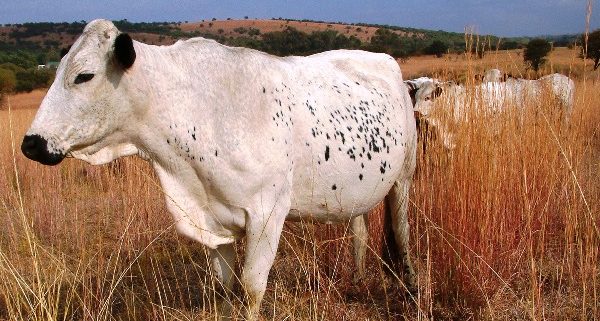Black quarter is preventable – African Farming
Consider the case of an animal health professional called out because a farmer’s year-old heifer has just died, and another animal looks listless with a swollen shoulder and slight lameness – the same symptoms presented by the dead heifer. These are the signs of black quarter. The painful truth is that the disease can be controlled by a combination vaccine that also protects against botulism and anthrax.
The dead heifer is worth at least R8 000, which is enough money to buy the black quarter vaccine for 80 animals every year for 20 years. The loss of the heifer would have covered the cost of black quarter vaccination for a communal herd of about 1 600 animals. The broader costs of such a loss also include the direct and indirect costs of raising the animal up to that age.
According to the Food and Agriculture Organisation, livestock is “the world’s third most important source of income” and “an asset for economic resilience and income”. It’s also estimated that about 600 million of the world’s poorest households keep livestock as a source of income. So, imagine the implication if a disease like black quarter negatively impacts even 1% of the poorest people.
WHAT IS BLACK QUARTER?
Also known as sponssiekte, or serotswana in Setswana, black quarter is a highly fatal bacterial disease of mainly cattle and sheep caused by spore-forming clostridial bacteria. These bacteria are naturally resident in the gut of the animal but may overgrow under certain circumstances like bruising in muscles. In sheep the disease is almost always the result of a wound infection and often follows some form of injury, such as shearing cuts, docking, crutching or castration. In cattle it occurs in the absence of wounds.
Clostridial spores can survive in soil for many years and may be brought to the surface by excavation, cultivation or flooding.
RECOGNISING THE SYMPTOMS
The disease is commonly found in unvaccinated, young, growing animals between six months and two years old, in good health. It is often characterised by an accumulation of bubbles under the skin, but mainly in the major muscles of especially the hind limb. The name sponssiekte was derived from the spongy feel of the affected tissue on a sick or dead animal when pressure is applied to the area. It is sometimes described as “crackling” under the skin.
On postmortem, the most common finding around the affected area is the obvious crepitant swollen appearance of the affected muscle(s) and the extremely dark discolouration (dark red to black) of the muscle. This may be more clearly seen when the muscle is cut in cross-section.
In some cases, the onset of the disease can be so sudden that animals may not be picked up as sick but will be dead the following day. Affected animals generally succumb to the infection within 12 hours to 48 hours.
HOW IT AFFECTS THE FARMER
Black quarter has close to 100% mortality. Very few animals have been successfully treated with penicillin but even animals that have recovered will most likely be scarred for life, which will impact their future productivity.
The cost of attempting life-saving treatments, the labour involved and the risk of drug residues will all have a negative effect on the farmer.
Sending the animals for emergency slaughter is not an option as they will fail the health inspection. Losses through mortality are also a threat to employment security and food security.
VACCINATION
Vaccination against black quarter is the cheapest way for farmers to protect their animals. Commercial combination vaccines are available that inexpensively protect against other clostridial diseases as well.
How we handle vaccines is extremely important. From the time the vaccine is dispensed to the farmer until it enters the animal’s body the farmer is responsible for the maintenance of the cold chain. This means ensuring the vaccine is
stored at a temperature between 2°C and 8°C until it is used. Loadshedding may impact the cold chain and it is a good idea to have back-up ice packs, especially when there are prolonged power supply interruptions.
Many vaccines are sensitive to direct sunlight. The farmer should carry them to the crush in a cooler box (ideally with ice packs).
Each time the vaccinator draws up the vaccine he (or she) should put the bottle back into the cooler box and close the lid. This will prevent the vaccine from getting warm and minimise exposure to direct sunlight.
Farmers should always work hygienically when vaccinating. It is not advisable to inject wet, soiled skins as this may introduce germs, resulting in abscesses that could interfere with the vaccine’s absorption from the vaccination site.
ENVIRONMENTAL MANAGEMENT
Carcasses should be destroyed by burning or deep burial in a fenced-off area to limit heavy spore contamination of the soil. If possible, avoid affected pastures.
It is generally believed that healthy animals have the greatest chance of benefitting from vaccines. This means that careful attention to the nutritional state of animals before vaccination helps a lot, especially considering the current season (winter). Meeting the nutritional needs, including trace mineral supplementation, of the animals gives their immune systems the best possible chance of benefitting from vaccines.
The easiest way is through the feed, but injectable delivery means the farmer knows exactly what each individual animal gets. There are often more vulnerable animals that have been bullied away from the feed and suffer from a reduced appetite.
TREATMENT
Treatment is seldom rewarding. Affected animals will most likely die despite treatment intervention, depending on the severity of the infection and/or the timing of the treatment intervention.
Speak to your local veterinarian or animal health technician regarding further details of various zoonotic diseases and basic vaccination programmes. Contact us at sello.maboe@obpvaccines.co.za.




Leave a Reply
Want to join the discussion?Feel free to contribute!